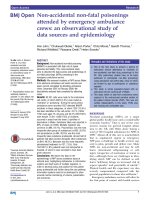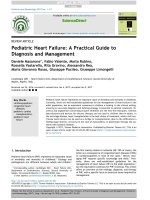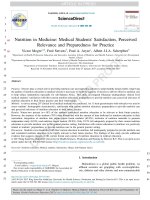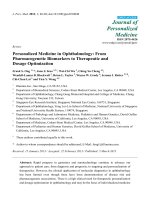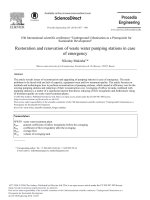Pediatric emergency medicine trisk 3678 3678
Bạn đang xem bản rút gọn của tài liệu. Xem và tải ngay bản đầy đủ của tài liệu tại đây (70.96 KB, 1 trang )
intraocular contents often sink back into the fracture, giving an enophthalmic
appearance. Conversely, proptosis can occur from orbital hemorrhage. Superior
wall fracture (roof fractures) may be associated with pulsating proptosis as a
result of communication between the orbit and intracranial cavity. Fractures of the
inferior wall may be associated with numbness of the ipsilateral malar region
caused by injury to the infraorbital nerve, which travels along the floor of the
orbit. Point tenderness and “step-off” signs during palpation of the bony rim of
the orbit is highly concerning for fracture, although in some orbital fractures
palpation may be remarkably normal.
The hallmark sign of orbital fracture is a restriction of extraocular movement.
Usually, the eye is unable to look away from the fracture site because of a
tethering of intraocular muscle or other orbital tissues in the fracture (see Fig.
28.6 ). Conversely, orbital hemorrhage at the fracture site can less commonly
displace the globe away from the fracture and make it difficult for the eye to look
in the direction of the fracture.
Entrapment may occur with orbital fractures, and can increase vagal tone,
triggering the oculocardiac reflex. This can result in bradycardia, heart block, and
in rare cases, hemodynamic instability.
Axial (proptosis) or coronal displacement of the globe is an ominous finding
because it may be a sign of orbital hemorrhage, which can cause compression of
the optic nerve, requiring emergency surgical intervention. Retrobulbar
hemorrhage, presenting with severe pain, vision loss, and proptosis, may also be
associated with orbital fractures. Enophthalmos is also a sign that should lead to
urgent radiologic evaluation and may require surgical intervention.
Triage Considerations
Children who have sustained severe blunt facial trauma and/or eye trauma should
be promptly evaluated. Soft tissue swelling may increase over time, making
evaluation more difficult. While the majority of orbital fractures are treated
conservatively, those with associated ocular or intracranial injury require
immediate intervention.
Management
Some controversy exists among ophthalmologists, otolaryngologists, and
craniofacial surgeons regarding the urgency for radiologic evaluation and surgical
intervention in the management of orbital wall fractures. If a decision is made to
proceed with radiologic imaging, CT scan of the orbit with both axial and coronal
views remains the standard. The brain should be included, particularly when an
